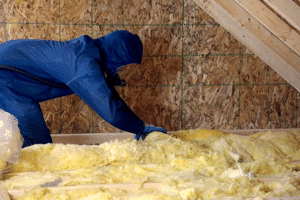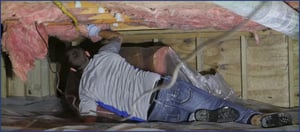How to Tell if Your House is Well Insulated


Something just doesn’t feel right in your home.
Cold floors, high energy bills, and uncomfortable rooms are plaguing you and the source is likely a lack of insulation, but how do you know for sure? While some areas of your home can be visually inspected, some spots aren’t as easy.
RetroFoam of Michigan has been insulating homes since 2002 and have helped thousands of homeowners with similar problems. We send out experts who know exactly how to tell if your home is insulated and what is causing the problems you’re experiencing.
In our continued efforts to educate homeowners, we will discuss some of the signs and symptoms of poor insulation and how to tell if your house is well insulated.
Signs of Poor Insulation
Did you know that around 90 percent of homes across the U.S. are under-insulated?
A home that is under-insulated is not only uncomfortable but will leave you paying more and more in monthly energy bills. No one wants to waste their money on that.
Let’s take a look at some of the signs you have a home in need of insulation.
Cold Rooms, Floors, and Walls
Do you have to wear extra layers and pile up blankets in your home?
If you’re suffering from cold floors, walls, or rooms that just won’t stay warm, then you likely don’t have insulation or need an update.
These problems stem from a lack of insulation specifically in the crawl space, rim joist, and walls.
Can’t Maintain a Constant Temperature
Are you finding that your home is either too hot in the summer or too cold in the winter?
This is caused by stack effect.
Stack effect is air movement throughout your home that makes it nearly impossible to keep it comfortable.
The rogue air comes in through your crawl space or basement, moves up through the floors and walls, and finally pushes out through the attic and roof. This is cold air in the winter and hot air in the summer, which puts added strain on your furnace and air conditioner.
This air is also causing added air pressure inside your home, which is looking for a way to escape.
High Energy Bills
Have you noticed that certain times of year your energy bills are through the roof?
Have you also noticed your AC unit and furnace are working overtime every season?
If your home can’t maintain a constant temperature due to under-insulation, your mechanics are going to attempt to put in the extra effort to get this done. That extra effort and work are coming right out of your pocket.
Cold Drafts Around the House
Do you feel cold drafts around your floorboards, outlets, windows, and doors?
This means not only aren’t the rim joist and walls of your home insulated, but neither are the spaces around the doors and windows.
Those drafts around your floorboards are coming from the rim joist and the ones coming from your outlets are due to no insulation in the walls.
Ice Dams on the Roof
Ice dams aren’t just annoying, they can also cause serious damage to your roof.
When the air you pay to heat is able to escape out of your uninsulated attic, the snow melts and collects at the edge of the roof. Water then pools at the ice dam created and causes leaks in your roof, then into the attic, and finally your ceiling.
The leaks alone are a costly project to fix, but the damage done to the roof will end up costing you even more. Not to mention the potential for mold and mildew growth.
Frozen Pipes
Frozen pipes are another symptom of little to no insulation that could end up costing you a lot of money.
Whether your pipes run through the crawl space or walls, if you don’t have insulation to keep that space above the outside freezing temperatures your pipes are going to freeze.
Dealing with a frozen pipe can be stressful enough, but it’s going to cost you money to fix it that pipe bursts.
Pests in Your Home
Rodents and bugs are gross and without good insulation, they’re moving on in.
These pests follow around the foundation or roof of your home looking for air leaks. To them, those air leaks mean there is a way for them to get inside.
Without proper insulation, you’re not just opening your home up to those air leaks – you’re opening it up to rodents and creepy crawlies.
How to Check House Insulation
Some areas of your home are easy to inspect for insulation because you can pop your head in and take a look, which other areas aren’t so easy.
 You can look in your attic, crawl space, or rim joist and physically see if those areas are insulated. During this inspection, you can also see if the existing fiberglass or cellulose have started to shift, settle, or sag. You can also tell if these materials have come in contact with moisture.
You can look in your attic, crawl space, or rim joist and physically see if those areas are insulated. During this inspection, you can also see if the existing fiberglass or cellulose have started to shift, settle, or sag. You can also tell if these materials have come in contact with moisture.
To inspect your attic, you will need to go up there and take a look. If you don’t have insulation, it will be easy to tell, but if there is a problem with the insulation you already have you’ll have to figure that out.
You’ll want to see if the cellulose has shifted. If it has, then you will want to rake it to make sure the attic floor is evenly covered. You may also have to add more cellulose to make sure you have enough coverage.
Checking the fiberglass will be different as it could have been installed in the attic floor joists or the attic roof deck. Either way, you will want to check and see if the fiberglass looks pink and fluffy, or if it looks dirty and wet. If it’s on the floor joist, is it flat looking? If it’s on the roof deck, does it look like it’s sagging? If these apply, then it is time to replace the insulation.
For the attic, you will also want to check to see if pests have made their home in the insulation as well. If this is the case, you will have to replace it.
 Checking in the crawl space is similar. You’ll want to get in there and check the fiberglass. This is a space where you can have a lot of moisture. Looking at the fiberglass you will be able to tell if mold has taken hold and started to grow.
Checking in the crawl space is similar. You’ll want to get in there and check the fiberglass. This is a space where you can have a lot of moisture. Looking at the fiberglass you will be able to tell if mold has taken hold and started to grow.
Even if mold isn’t present yet if the fiberglass is sagging it has likely become wet at some point.
Checking to see if your walls have insulation is a different story because those cavities are enclosed.
You can check your walls by removing outlet and light switch covers to get a little bit of a glimpse. You can also drill a ¾-inch hole someplace inconspicuous to take a look.
Keep in mind when inspecting your existing insulation that materials like fiberglass can be hazardous to handle as it can embed in the skin and be inhaled. Cellulose, once disturbed, can spread dust all over your house.
What to Do if You Have a Poorly Insulated House
Now that you know some of the signs, you’ll need to do something about it.
The first steps should be to do your research to see what insulation materials meet your needs and budget. Next will be to buy the home insulation that will give you the comfortable home you’ve always dreamed of.
If you’d like to read about the evidence that your home may need insulation, check out our checklist 18 Signs and Symptoms it May Be Time to Update Your Insulation.
About Amanda Emery
Amanda previously has worked as a breaking news and crime reporter, TV news producer, and editor in Flint and Detroit. Throughout her career as a journalist, she has won several awards from The Society of Professional Journalists - Detroit Chapter and the Michigan Press Association. As part of the RetroFoam of Michigan family, Amanda uses her experience as a journalist to write content that will help educate homeowners on the benefits of foam insulation. When Amanda isn’t writing, she’s spending time with her husband and rescued huskies. She also loves knitting, making art, cooking, and hosting dinner and a movie night for friends and family.


